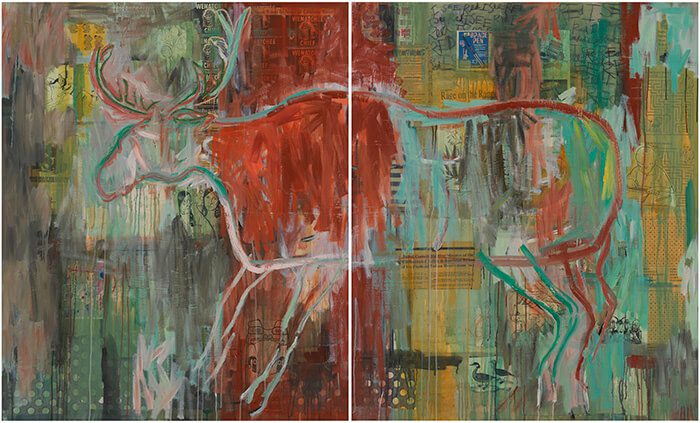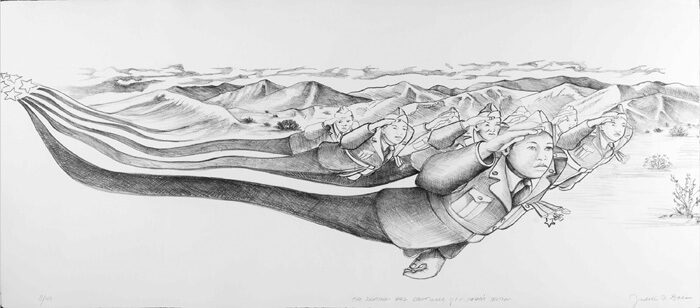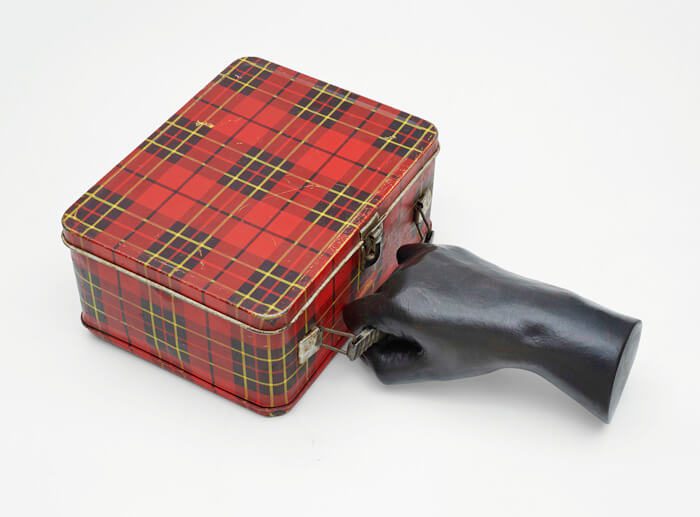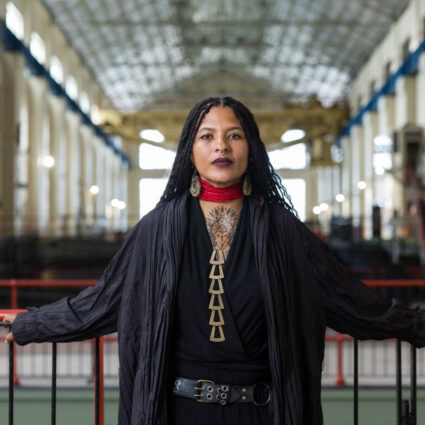In Poetic Justice at the New Mexico Museum of Art, the social impacts and artistic contributions of Judith F. Baca, Mildred Howard, and Jaune Quick-to-See Smith are on display.

Poetic Justice: Judith F. Baca, Mildred Howard, and Jaune Quick-to-See Smith
October 9, 2021–June 19, 2022
New Mexico Museum of Art, Santa Fe
Currently on view through June 19, 2022 at the New Mexico Museum of Art, Poetic Justice: Judith F. Baca, Mildred Howard, and Jaune Quick-to-See Smith, is a group exhibition showcasing the work of three contemporaries whose respective practices integrate social justice and aesthetic concerns.
The show opens with the work of New Mexico resident Jaune Quick-to-See Smith, a registered member of the Confederated Salish and Kootenai Nation in Montana. The eighty-one-year-old painter is the first contemporary Native artist to have work collected by the National Gallery of Art in Washington D.C. She’s also been a longstanding advocate for contemporary Native American art.
In this exhibition, she presents thirteen xerographic drawings from Paper Dolls for a Post Columbian World (1991), including two drawings of paper dolls and two paper doll outfits for the Plenty Horses doll. The works, made with deceptively casual marks, leverage low-fi reproduction techniques and a Pop Art sensibility to reflect on the country’s “post-contact” colonial history—upon arrival in North America, Christopher Columbus’s priests distributed paper dolls to Native American people to “teach” them about humanity, establishing the settler as an archetype of civilization in order to subjugate others.
Additional Quick-to-See Smith works include installations and paintings that collage commercialized conceptions of “Indian-ness” through newspaper and advertisement clippings. The artist uses these found materials as backgrounds for large expressive and figurative paintings depicting iconic objects like an Indian nickel in I See Red: Indian Head Nickel (1994) as well as Ronan Robe #4 (1997), a hanging canvas treated like an animal hide.
The work of Judith F. Baca, a seventy-five-year-old Los Angeles-based artist and educator, includes a selection of digital reproductions and original process sketches of her first large-scale mural and masterwork, The Great Wall of Los Angeles.

Created in the style of Mexican mural traditions from the 1930s and listed in the National Register of Historic Places, the half-mile mural began in 1976 and depicts a diverse people’s history of Los Angeles as far back as the dinosaurs. It is also emblematic of how public art projects can engage and transform communities. The wall was completed over multiple summers with the help of more than 400 community members including academics and at-risk youth.
The exhibition also includes Baca’s self-portrait photo series of twelve prints, La Pachuca (1975). In the same way that Quick-to-See Smith plays with Native American clichés, Baca consciously employs popular stereotypes projected on and created within Chicanx culture to refract their effect—in this case, feminizing a male archetype, La Pachuco.
The final portion of the gallery is dedicated to San Francisco Bay Area artist, arts administrator, and educator Mildred Howard. Best known for her multi-media installations, the seventy-six-year-old has had a lasting impact on northern California while managing art and community programs; for example, she served as the executive director of Alice Waters’s Edible Schoolyard program at Martin Luther King Jr. Middle School in Berkeley.
Her portion of the exhibition opens with Tha Dogg Express (2021), a model train set with box cars, made from bank deposit boxes, that circle a small oval track and bear the names of historically Black areas like West Philly, Detroit, and Baltimore. Another work, Square Meal (2021), includes a black cast-bronze hand holding a red tartan lunch box in a fist. As with the train car, Howard highlights a relationship between the idea of wealth (or sustainability) and its access—themes that are present in Quick-to-See Smith’s paintings of the United States and Indian nickels, and Baca’s multiple references to the southern border.
Additionally, framed monoprints from the Millennials & XYZ series depict contemporary figures from Howard’s life and popular culture printed over vintage newspaper pages, suggesting the steady empowerment of Black Americans. As Howard described in an interview with the San Francisco Museum of Modern Art, “The concentration that I’ve been focusing on is on memory, on history, on place, on class—it’s about the everyday. Everyday objects. Everyday people.”

Each of these artists transcends the discrete bounds of individual artworks to celebrate diversity, complexity, and undermine a history of Eurocentric priority. Poetic Justice is impossibly limited in its capsule overview of the three artists’ accomplishments—one can’t help but wish the show expanded beyond the three allotted rooms. Yet, Baca, Howard, and Quick-to-See Smith all make clear that a rich artistic inquiry inevitably transcends the artwork, reverberating beyond the studio and into the community to celebrate the richness of our society.
Poetic Justice: Judith F. Baca, Mildred Howard, and Jaune Quick-to-See Smith is scheduled to remain on view through June 19, 2022 at the New Mexico Museum of Art, 107 West Palace Avenue in Santa Fe.




